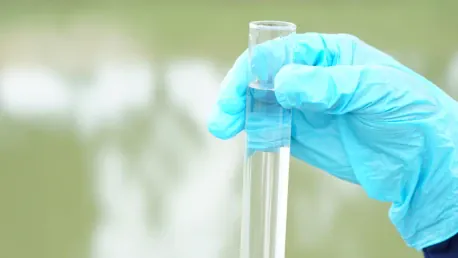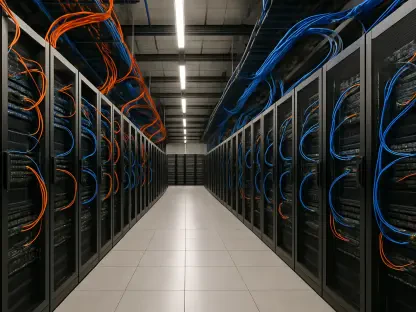Water quality monitoring has always been a complex and labor-intensive task, particularly for wastewater treatment plants, drinking water utilities, and industrial manufacturers. These entities must vigilantly monitor various and changing chemistries while new contaminants continuously emerge. KETOS SHIELD disrupts this challenging status quo by introducing a sophisticated and centralized platform capable of monitoring up to 36 different compounds in real-time, significantly lightening the load on plant operators. This artificial intelligence-driven system not only facilitates instantaneous detection and response to anomalies but also provides predictive insights for the entire water matrix. Offered through a Data-as-a-Service model, SHIELD shifts data management risks to the provider, allowing users to focus on maintaining water safety and regulatory compliance.
Challenges in Water Quality Monitoring
The Complexity of Traditional Methods
Traditional water quality monitoring methods are time-consuming and resource-intensive. Operators must constantly be on alert, managing multiple, often fluctuating chemistries. The emergence of new and poorly understood contaminants further complicates this task, making it difficult to ensure consistent water quality. These methods typically involve static water testing and manual calibrations, which not only consume significant time but also demand continuous scrutiny to maintain accuracy and reliability. As industries grow and environmental regulations become more stringent, the need for more efficient and comprehensive monitoring solutions has become ever more pressing.
In addition to these complexities, traditional methods lack the agility to promptly detect anomalies and respond to emergency situations. This inadequacy is particularly pronounced when dealing with contaminants that require immediate action, where delays or inaccuracies in data can have severe consequences for public health and environmental safety. Consequently, the water management sector has been increasingly turning its attention to innovative solutions that promise to overcome these intrinsic limitations, paving the way for more advanced, integrated, and automated methodologies.
The Need for Continuous Vigilance
Wastewater treatment plants, drinking water utilities, and industrial manufacturers face significant challenges in maintaining water quality. The job demands constant vigilance and the ability to adapt to changing conditions. This continuous monitoring is crucial for regulatory compliance and public health safety. Plant operators are expected to keep abreast of shifting chemically diverse environments and rapidly evolving regulatory standards, ensuring that all detected contaminants are accurately identified and addressed. The dynamic nature of water systems necessitates round-the-clock surveillance, which poses a heavy burden on existing manual processes.
Moreover, the stakes are high; failure to detect a contaminant or to meet regulatory standards can lead to severe legal, financial, and reputational repercussions. The introduction of new contaminants, some of which may have yet to be fully understood or regulated, further amplifies the urgency for sophisticated monitoring systems. In an era where water scarcity and pollution are becoming more prevalent, there is an irrefutable need for smarter technologies that can provide reliable, real-time data and actionable insights, facilitating more efficient and responsive water quality management.
Introduction of KETOS SHIELD
Overview of SHIELD Technology
KETOS, a water management technology developer, has introduced a platform called SHIELD. This platform aims to streamline and improve the efficiency of water quality monitoring by detecting and monitoring dozens of heavy metals, inorganics, and nutrients. A PFAS-specific module is also in development, showcasing the platform’s adaptability to emerging contaminants. The SHIELD platform is designed to replace outdated static testing methods and manual calibrations with a dynamic, real-time monitoring system. By doing so, it significantly reduces the operational complexity and resource demands traditionally associated with water quality management, allowing for a more proactive and responsive approach.
Furthermore, SHIELD goes beyond basic detection by leveraging machine learning and AI to provide predictive insights, identifying potential risks before they become critical issues. This predictive capacity is invaluable in preventing contamination events and ensuring compliance with increasingly stringent regulatory requirements. KETOS has positioned SHIELD as a forward-thinking solution that not only meets current water monitoring needs but is also prepared to address future challenges through continuous innovation and adaptability.
Real-Time Monitoring Capabilities
The SHIELD technology can sense 36 compounds down to parts per billion in real-time from a single automated and centralized system. This eliminates the need for static water testing and manual calibrations, reducing the inventory of required equipment. The integration of AI provides actionable insights, enhancing decision-making processes. This capability is crucial in addressing the complexities of modern water systems, where rapid detection and response to contaminants can mean the difference between compliance and violation of health standards. The high sensitivity of SHIELD ensures that even trace amounts of hazardous substances are detected, providing unparalleled reliability and peace of mind for operators.
Additionally, the platform’s real-time data collection and analysis capabilities streamline the entire monitoring process. It enables plant operators to receive immediate alerts when contaminants are detected, and understand their potential impact through detailed analytics. This ability to quickly react to and manage anomalies or irregularities is not only essential for maintaining water quality but also for ensuring operational efficiency and cost-effectiveness. With SHIELD, the cumbersome and often delayed process of traditional monitoring methods is replaced by a seamless, automated system that delivers precise and timely information.
Functioning of The Technology
Integration with Treatment Processes
The platform employs sensors, robots, and machine learning to detect and analyze anomalies in water chemistry and predict trends. It is further integrated with the treatment process itself, meaning it can automatically activate treatment systems when irregularities are detected. This seamless integration ensures that water quality is maintained without manual intervention. Such an integration translates into a highly efficient system where data is continuously monitored, and corrective actions are automatically deployed, minimizing response times and amplifying the impact of real-time data.
The use of advanced robotics and AI within the SHIELD platform not only enhances accuracy but also ensures consistency in water treatment processes. This ensures compliance with stringent regulatory standards, mitigating the risk of human error and significantly reducing the manual labor traditionally required. By enabling automatic adjustments and treatments based on real-time data, SHIELD represents a modern, automated approach to water quality management that anticipates issues and addresses them proactively, thus safeguarding public health and the environment.
Customizable Parameter Thresholds
The SHIELD system allows parameter thresholds to be customized, providing a buffer that aids operators in maintaining regulatory compliance. The flexibility to switch or add new chemicals for monitoring makes the technology adaptable to changing water compositions and regulatory demands. This adaptability is crucial for staying ahead of evolving regulations. Operators can set specific thresholds for various compounds, tailored to meet local and federal standards, ensuring that their water systems remain compliant even as regulatory landscapes change.
Moreover, this customization capability allows for more precise monitoring tailored to the unique needs of each plant or facility. By offering a personalized approach to water quality management, SHIELD not only simplifies the compliance process but also enhances the overall efficiency and effectiveness of water treatment operations. This ability to adapt swiftly to new regulatory standards or emerging contaminants places SHIELD at the forefront of water management technology, providing a proactive solution in an industry where compliance and safety are paramount.
Reducing Operational Pressure
Continuous Data and Insights
SHIELD significantly reduces the burden on plant operators by offering continuous data and insights. This allows operators to focus more on ensuring water safety rather than managing budgetary constraints and manual testing. The platform’s real-time monitoring capabilities provide a proactive approach to water quality management. Continuous monitoring eliminates guesswork and ensures that potential issues are identified and addressed promptly, preventing minor anomalies from escalating into major problems. This real-time feedback loop enhances operational efficiency by providing operators with the precise data they need to maintain optimal water quality at all times.
Additionally, the automation provided by SHIELD means that operators can allocate their time and resources more strategically, focusing on critical tasks rather than routine monitoring and testing. This shift not only improves efficiency but also allows for a more focused approach to ensuring water safety and regulatory compliance. By reducing the reliance on manual processes, SHIELD enhances the overall productivity and effectiveness of water treatment operations, leading to better outcomes for public health and environmental safety.
Shifting Data Management Responsibilities
Industry experts recognize the value of shifting data management responsibilities to specialized service providers. By offering SHIELD through a Data-as-a-Service model, KETOS allows users to focus on core operational goals while the provider manages the complexities of big data. This shift enhances efficiency and reduces operational pressure. As data management becomes increasingly complex, this approach ensures that water management professionals can rely on specialized providers for accurate data analysis and reporting, freeing them from the burden of managing extensive datasets.
Furthermore, the Data-as-a-Service model offers scalability and flexibility, allowing operators to adjust their monitoring and reporting capabilities as needed. This ensures that they can meet both current and future regulatory requirements without needing to invest heavily in new infrastructure or staffing. By outsourcing data management to trusted providers, water management facilities can guarantee the integrity and reliability of their monitoring processes, ultimately leading to better compliance and more effective water quality management.
Integration with Third-Party Data
Versatility and Comprehensive Decision-Making
SHIELD is designed to incorporate data from various sources, including labs and other tools, making it versatile and comprehensive for decision-making processes. This integration ensures that all relevant data is considered, providing a holistic view of water quality. By consolidating data from different sources, SHIELD delivers a unified platform where operators can assess and interpret water quality metrics more accurately and thoroughly. This approach enhances the decision-making process by providing a comprehensive understanding of water conditions, leading to more informed and effective operational strategies.
Additionally, the platform’s ability to integrate third-party data supports collaboration and data sharing across different stakeholders, including regulators and other water management entities. This collaborative model not only improves transparency but also fosters a more coordinated response to water quality challenges. By bringing together a wide array of data, SHIELD ensures that every aspect of water quality is monitored and managed proactively, delivering superior outcomes in regulatory compliance and public health protection.
Support from Industry Experts
Industry experts, including Amir Cahn and Monica Ellis, endorse the technology, emphasizing its potential to transform water management. They highlight the benefits of real-time insights and the ability to shift data management risks to outside providers, enhancing overall efficiency and effectiveness. Their support underscores the reliability and necessity of integrating advanced technologies like SHIELD into modern water management practices to tackle the growing challenges posed by water quality monitoring.
Experts emphasize that the real-time, automated nature of SHIELD enables a level of precision and responsiveness that traditional methods cannot match. This capability is instrumental in maintaining regulatory compliance and ensuring public health safety in an increasingly complex and demanding landscape. By leveraging advanced AI and machine learning, SHIELD is poised to set a new standard in water quality management, providing the tools necessary to address both current needs and emerging challenges effectively.
Developments on PFAS Monitoring
Expanding SHIELD’s Capabilities
KETOS is expanding SHIELD’s capabilities to include a module for PFAS (specifically PFOA and PFOS), with detection technology expected to be ready by 2026. Given current PFAS detection challenges, this module represents a significant advancement in water quality monitoring. PFAS, often referred to as “forever chemicals,” present unique and persistent challenges due to their resistance to degradation and potential health impacts. The addition of PFAS-specific monitoring capabilities in SHIELD underscores KETOS’s commitment to addressing these critical and emerging contaminants through continuous innovation.
The development of this new module indicates that KETOS recognizes the growing regulatory focus on PFAS and the need for advanced detection technologies to ensure compliance. This proactive approach ensures that water treatment facilities are well-equipped to meet forthcoming regulations and protect public health more effectively. By introducing PFAS-specific monitoring, SHIELD further enhances its utility and positions itself as a comprehensive and future-proof solution for water quality management.
KETOS PRISM
In parallel with SHIELD, KETOS has developed PRISM, a platform aggregating PFAS data from multiple sources to support water risk assessment, permit compliance, and legal risk evaluations. This comprehensive approach ensures that all aspects of PFAS monitoring and management are addressed. PRISM serves as a valuable tool for stakeholders by providing a centralized repository of PFAS data, facilitating more effective and informed decision-making.
Through PRISM, KETOS not only addresses the immediate need for comprehensive PFAS data analysis but also anticipates and adapts to future regulatory and environmental developments. This platform represents an essential companion to SHIELD, ensuring that water management efforts are robust, data-driven, and capable of meeting evolving challenges. Together, SHIELD and PRISM embody KETOS’s innovative approach to water management, offering holistic, efficient, and forward-thinking solutions to one of the most pressing issues of our time.
Overarching Trends and Consensus Viewpoints
Traditional Methods vs. Advanced Technologies
There is a consensus that traditional water quality monitoring methods are time-consuming and resource-intensive. The integration of advanced technologies, specifically AI and automation, can significantly streamline and enhance the accuracy of water quality monitoring. Traditional methods often struggle to keep pace with the rapid advancements in environmental science and the increasing complexity of water systems. As a result, there is a growing consensus that advanced technologies must be embraced to ensure effective water quality monitoring and compliance.
The shift towards smart technologies like SHIELD represents an evolution in water management practices, driven by the need for more efficient, precise, and proactive approaches. AI and automation bring unparalleled advantages in terms of data processing, real-time monitoring, and predictive analytics, enabling water management entities to address challenges more effectively and sustainably.
Adaptability to Regulatory and Environmental Conditions
Traditional methods of water quality monitoring are both time-consuming and resource-heavy, requiring constant vigilance from operators managing numerous, often fluctuating chemical levels. The rise of new, less understood contaminants complicates the process, making it challenging to consistently maintain water quality. These methods rely on static water testing and manual calibrations, consuming not just a lot of time but also demanding continuous oversight to ensure accuracy and reliability. As industries expand and environmental regulations get stricter, there’s a growing need for more efficient and comprehensive monitoring solutions.
Moreover, traditional methods aren’t agile enough to quickly detect anomalies or respond to emergencies. This deficiency is especially critical for contaminants that need immediate intervention, where delays or inaccuracies can severely impact public health and environmental safety. Thus, the water management sector is increasingly exploring innovative solutions to overcome these inherent limitations, opening the door to more advanced, integrated, and automated approaches in water quality monitoring.









